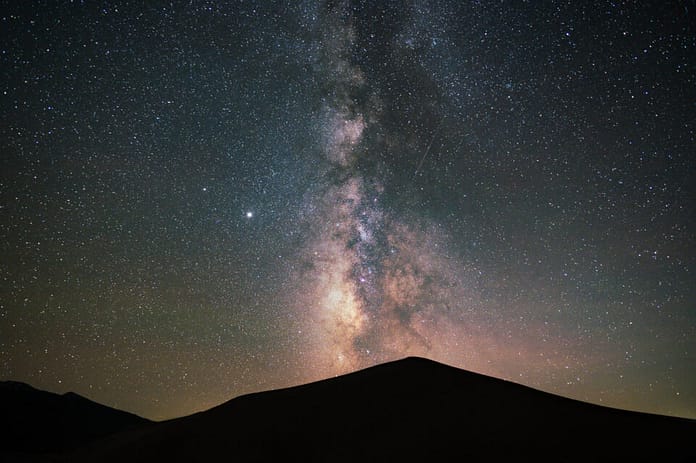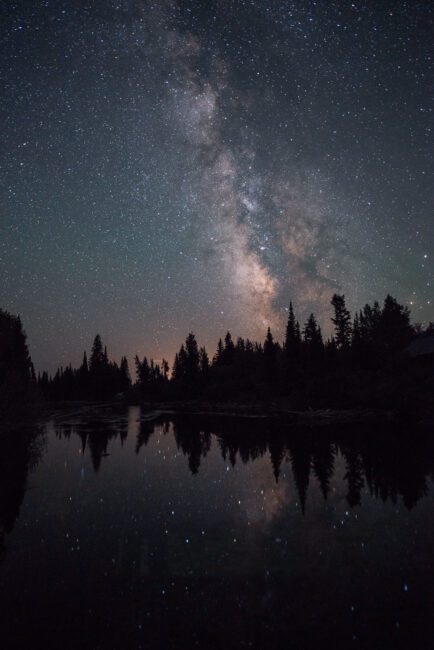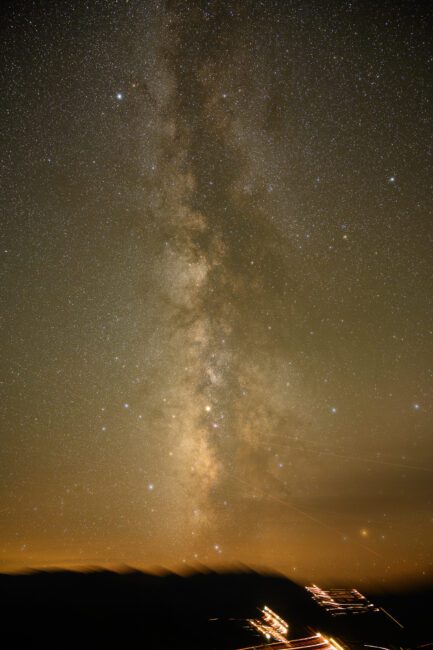When you’re photographing the night sky, it can be a serious challenge to pick the right camera settings. Shutter speed in particular is a difficult one, forcing you to fight between capturing enough light or capturing sharp stars. Two popular rules aim to help – the 500 rule and NPF rule – but how do they work in practice? Is one better than the other? This article explains everything you need to know.
Balancing Star Movement and Noise
Let me start by explaining the problem at hand, and why it’s not as easy to solve as it may seem.
With ordinary (daytime) landscape photography, you generally can use any shutter speed you want and get sharp pictures, assuming you’re on a stable tripod and nothing in the scene is moving. For example, the landscape photo below is shot at 60 seconds and is plenty sharp:
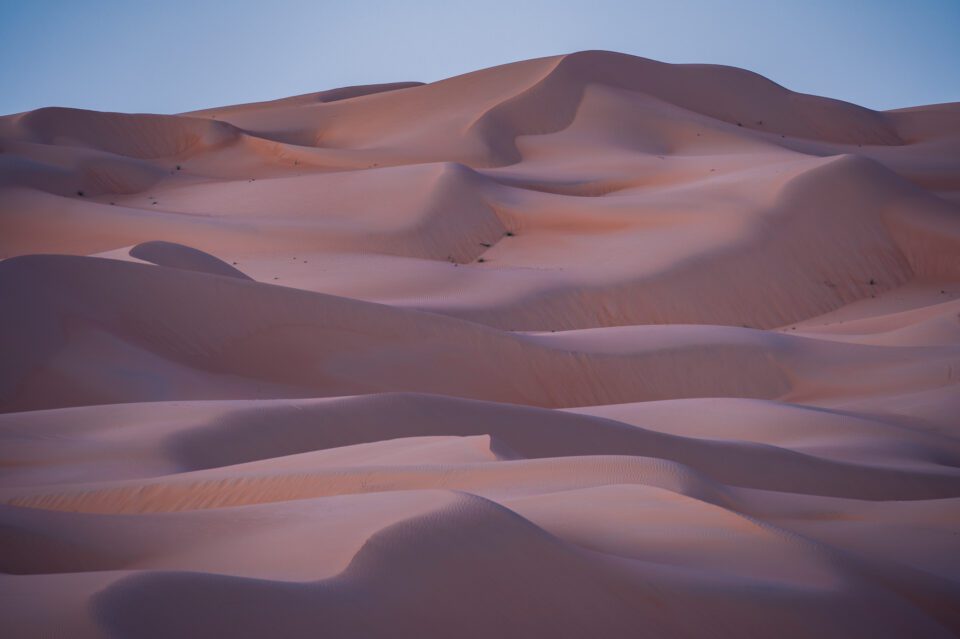
However, that’s not possible with Milky Way photography. Because of the Earth’s rotation, the stars move surprisingly fast across the night sky. It can be tough to see that movement with your eyes, but your camera will pick it up. Beyond about 30 seconds of exposure, you’ll get noticeable blur in the stars, even with an ultra-wide lens.
The image below, shot at 133 seconds, shows how this blur can get out of control:
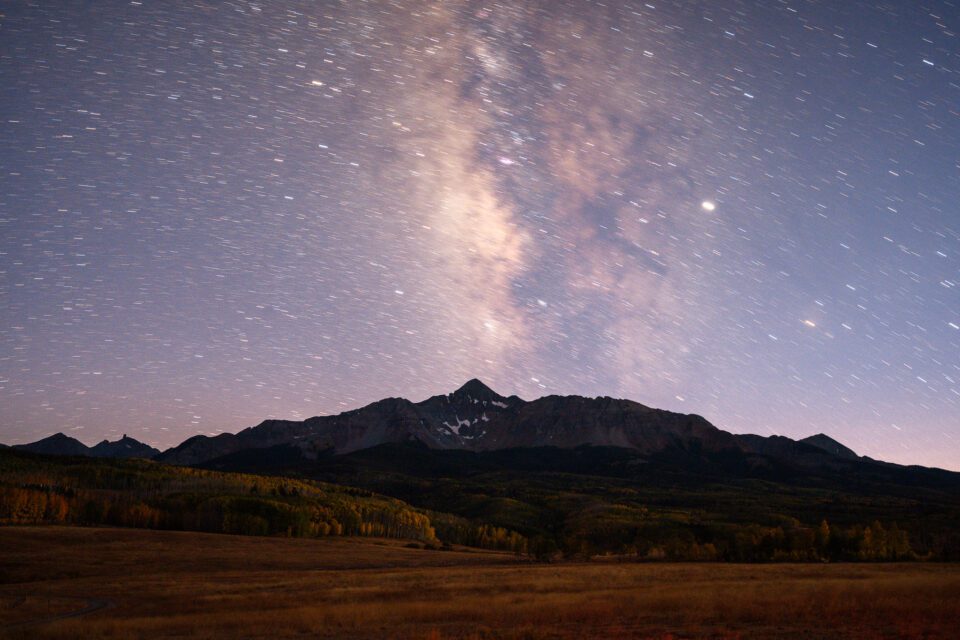
Even at seemingly safe shutter speeds such as 20 or 25 seconds, there will be some blur when you zoom into the photo. In fact, with a typical wide-angle lens, you won’t completely eliminate star movement until you’re at shutter speeds as short as 5 or 10 seconds!
Here’s a demonstration of that. The images below are extreme crops of astrophotography images – the first one captured at 8 seconds, and the second at 20 seconds. I used a 14mm ultra-wide lens in both cases:
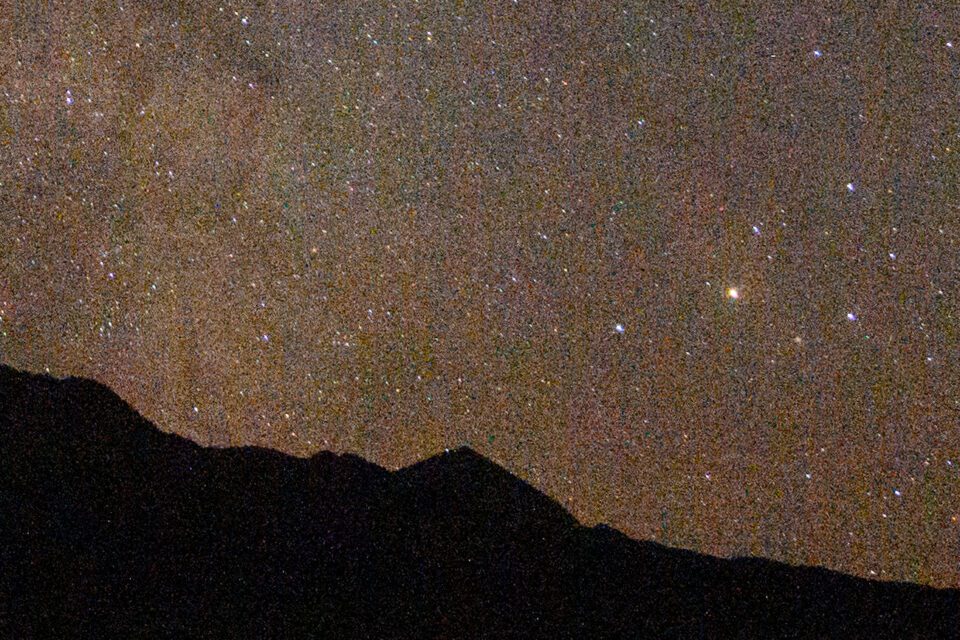
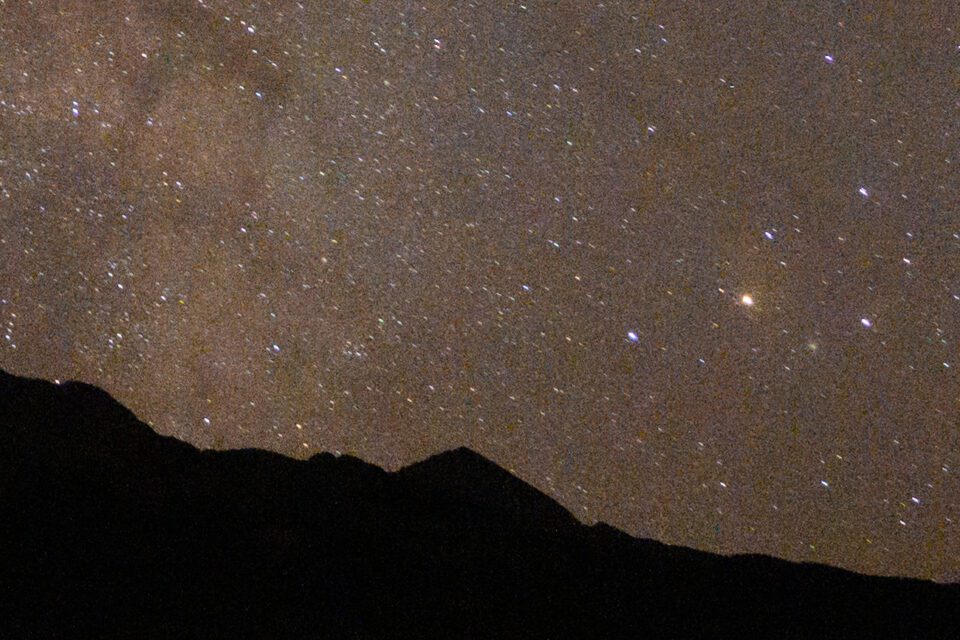
If you look closely (or click to see larger), you can tell that there’s more star movement in the image taken at 20 seconds, while the image at 8 seconds has essentially no motion blur. However, that’s not the biggest difference between the two images. More importantly, the photo taken at 20 seconds captures more than twice as much light as the other photo, resulting in a better signal-to-noise ratio. As a result, it looks cleaner overall, with less noise and fewer discolored pixels.
So, what would you say is the optimal balance between motion blur and noise? Is it better to get pinpoint stars even at the expense of noise, or is a longer shutter speed preferable – maybe even longer than in the demonstration above? It’s a dilemma.
My perspective is this: Every photographer should make a decision about their “preferred balance” between noise and star movement – and I’ll explain more about this decision below. However, once you’ve figured out your own preferred balance, it’s possible to recreate it perfectly every time you take a Milky Way photo, no matter the other factors at hand (like your focal length or the direction you’re facing).
That’s where the 500 rule and NPF rule come into play. In theory, these rules make it easy to achieve the same preferred balance every time you take a Milky Way photo. However, in practice, both rules have their own flaws.
To make it easier to understand those flaws, let’s take a look at the different factors that influence motion blur in astrophotography.
Factors Influencing Motion Blur
There are three major factors that affect how much motion blur you’ll capture when photographing the stars (assuming a stable tripod and no tracking head). Those are your shutter speed, focal length, and the direction you’re facing.
I’ve already demonstrated how shutter speed can affect the motion blur in your stars, so let’s take a look at the other two factors: focal length and the direction you’re facing.
Focal length matters for an obvious reason: As you zoom in, you magnify everything in your photo, including motion blur. (Using a crop sensor camera – or cropping your photo in post-processing – does the same thing.) For example, the following photo is taken at 24mm and 20 seconds, and while it has some star movement, it’s difficult to notice at web resolution:
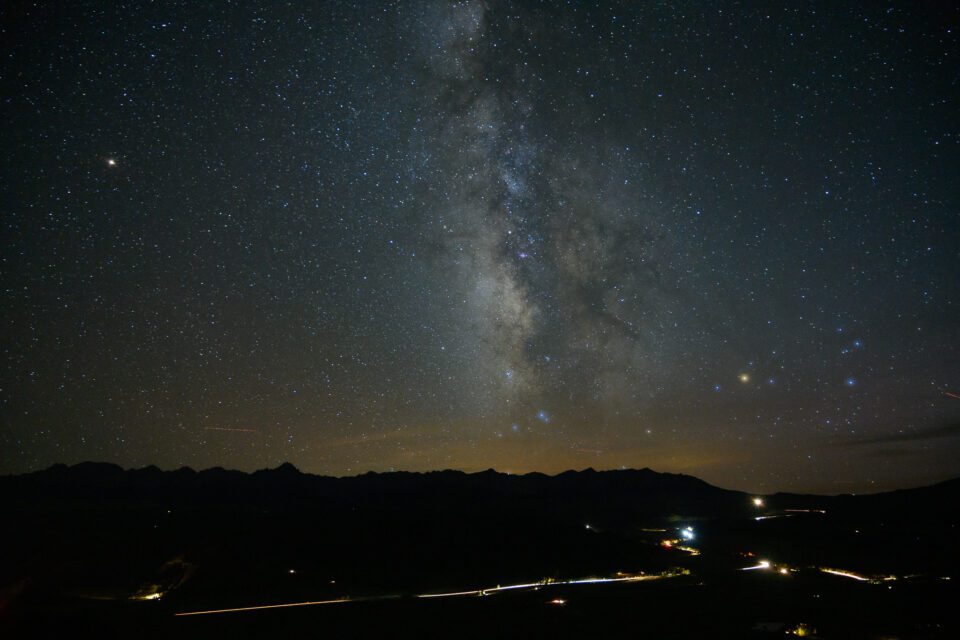
By comparison, I took the following photo on the same evening at 67mm, all other settings identical:
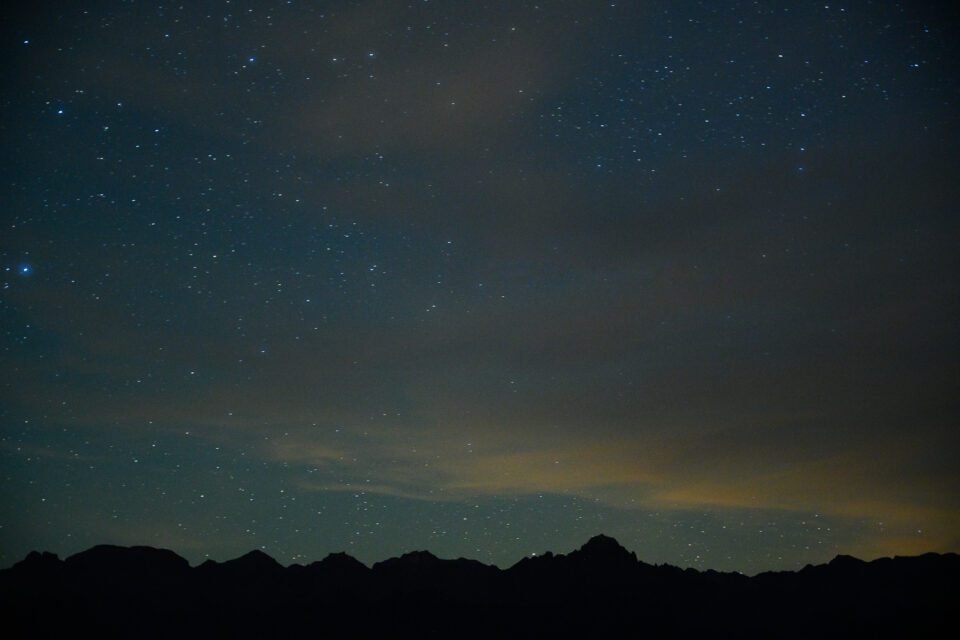
If you’re on a desktop, I recommend clicking on either of these photos to view them larger and scroll between them. It should be pretty clear that the second image has larger star trails. If it’s not clear, or you’re viewing it on a smaller screen, here’s a 100% crop from both photos (the “before” at 24mm and the “after” at 67mm):

Along with your focal length, another important factor is the direction you face. Most photographers know that the stars are rotating more slowly around the North Star (or the equivalent “South celestial pole” area if you’re in the Southern Hemisphere). And, in turn, the fastest stars moving across the night sky are those along the celestial equator, which is the region directly between the North and South celestial poles.
Here’s a comparison between a photo taken toward the North Star, and then closer toward the celestial equator, to demonstrate how star movement changes depending on your composition. Both of these are 120 second exposures:
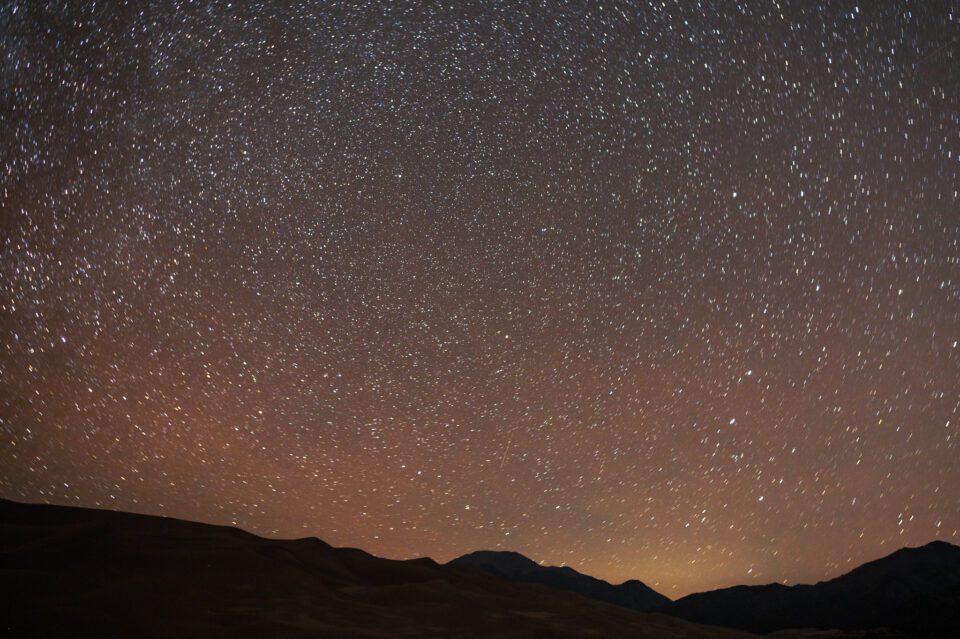
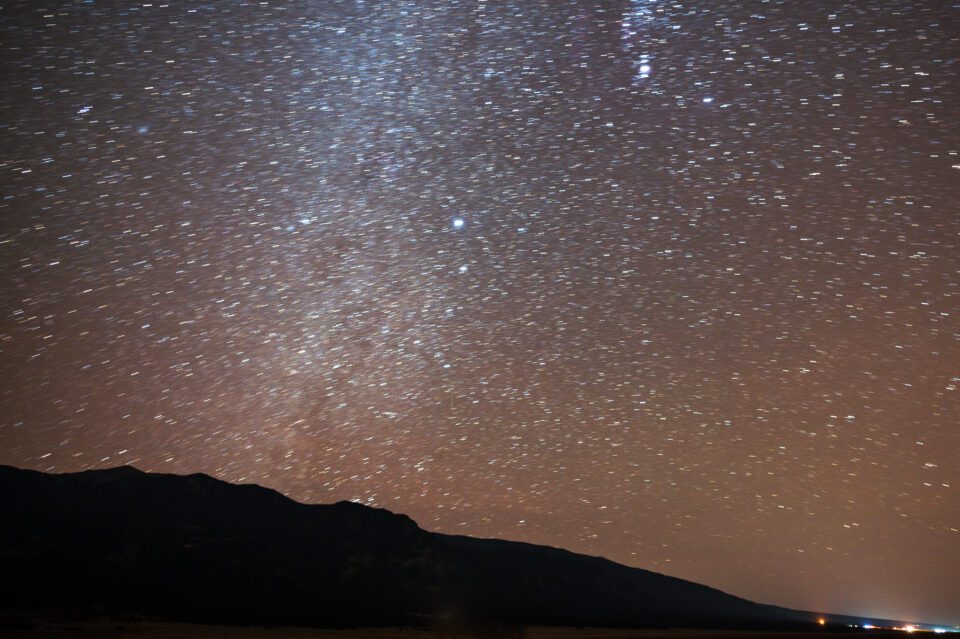
The best shutter speed is going to be shorter when your stars are close to the celestial equator. The technical term for a star’s distance from the celestial equator is its “declination,” which is measured in degrees.
Along with those three factors, there are a few other variables that aren’t quite as important, but still matter: your camera’s pixel size, lens quality, diffraction at your chosen aperture, and focus precision. These can all be lumped into a variable I call “smallest theoretical star prior to everything else.” I’m proud of this name because it really rolls off the tongue.
A good way to imagine the smallest theoretical star variable is this: If you miss focus slightly, the stars are all going to be a bit larger in your image. As a result, if they move a few micrometers during your exposure, it’s not going to give you quite as obvious of a star trail, compared to a smaller star moving the same distance. Basically, like this:
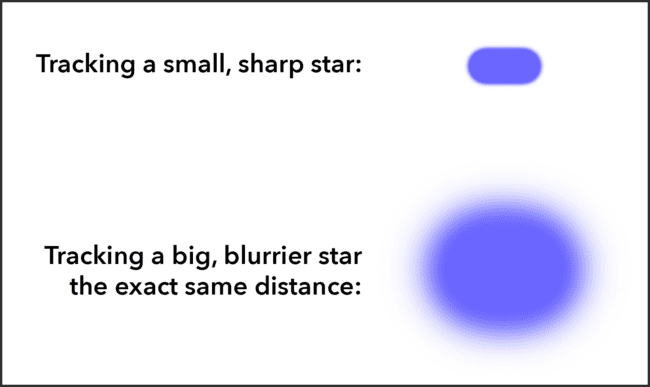
So, a bit ironically, if your stars are bigger/blurrier in the first place, you can get away with a longer shutter speed before you notice the motion. Not that I’m suggesting you miss focus or use a low resolution camera sensor just because of this effect. You’ll lose more sharpness and image quality than you gain from doing so. However, if you’re already using a lower quality imaging system, it’s going to cause enough blur that it could hide some of the star movement, meaning it’s best to use a slightly longer shutter speed. So, the “smallest theoretical star” variable still matters (and even factors into the NPF rule’s equation).
That’s enough background information. Let’s compare the 500 rule and NPF rule to see how well they work for Milky Way photography, and which shutter speed you should actually use.
The 500 Rule
By far the simpler of the two popular rules for astrophotography is the 500 rule. It recommends that your shutter speed is equal to 500 ÷ Equivalent Focal Length.
So, if your full-frame equivalent focal length is 20mm, the 500 rule would suggest that you use a shutter speed of 500 ÷ 20 = 25 seconds. If you’re using a 50mm lens instead, it would recommend using a 10 second shutter speed (500 ÷ 50).
The benefit of the 500 rule is that it’s easy to remember, and it’ll get you in the right ballpark for your Milky Way shutter speed. That’s likely why it’s become such a popular tool among photographers who are first learning astrophotography.
The biggest drawback with the 500 rule is that it doesn’t take into account the direction you’re facing (nor any of the other factors like pixel pitch or blur from diffraction). The formula only ever spits out a different shutter speed when you change focal length, which doesn’t account for all the real-world factors that apply.
The other major drawback of the 500 rule is that it’s too lenient. In almost every case, regardless of your composition, you’ll get more blur than ideal when using the 500 rule. This particular issue is easy to fix by using the “400 rule” or “300 rule” instead (the same formula, but with 400 or 300 rather than 500). However, this doesn’t fix the issue of the direction you’re facing, so it’s a bit like putting a bandaid on a garden hose.
That said, if you like the idea of simplicity, this rule isn’t worthless. I personally use the “300 rule” version when I know that my composition includes stars along the celestial equator (again, the fastest-moving stars in the night sky). This means I’m at 20 seconds of exposure with my 14mm lens and 15 seconds with my 20mm lens when those fastest-moving stars are in my composition.
Of course, the stars along the celestial equator won’t be in all your astrophotography images, but it’s actually quite common that they will, especially if you’re using an ultra-wide lens. Case in point: The constellation Orion directly intersects with the celestial equator, and Orion is not terribly far from the core of the Milky Way (it’s a bit “up and to the right” of the core if you’re in the Northern Hemisphere). So, the 500 rule – or, at least, the 300 rule version of it – still has some value.

The NPF Rule
A more complex formula for calculating shutter speed at night is called the NPF rule. Here’s the formula:

- t = Recommended shutter speed
- k = Multiplication factor
- N = F-number
- f = Lens focal length (millimeters)
- p = Pixel pitch (micrometers)
- δ = Minimum declination
The key is to memorize this as soon as possible. Once you do, it just takes some quick mental math to get sharp photos every time.
Ok, I’m kidding! This calculation is built into a number of astrophotography apps directly, like PhotoPills, Pin Point Stars, and a few others. You’ll need to input some of the variables on your own, but once you do, the app will tell you the optimal shutter speed without any calculations required on your end.
Here’s how it looks in PhotoPills, for example:
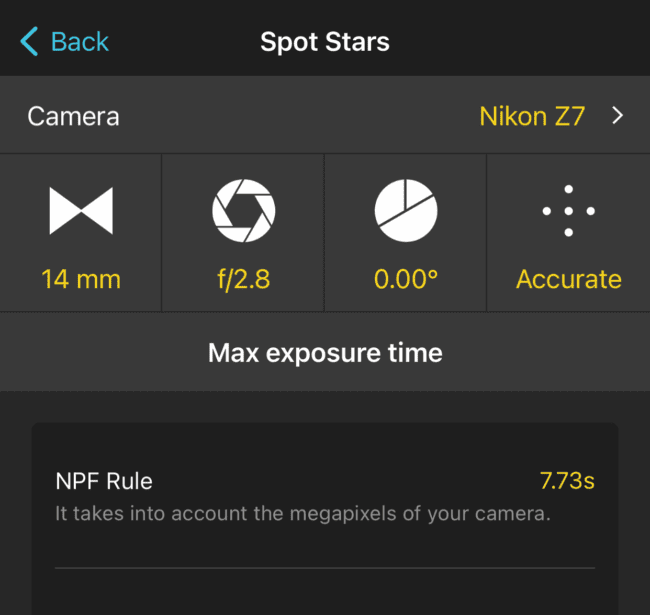
Unlike the 500 rule, the NPF rule takes into account the direction you’re facing (AKA “minimum declination” in the formula), as well as your pixel pitch and the diffraction from your chosen aperture.
Except… something seems wrong. In the screenshot above, the NPF rule says to use roughly an 8 second shutter speed with the Nikon Z7 and a 14mm lens. If you recall the demonstration from the start of this article, that’s exactly what I did – and it was clear that the 20 second shutter speed had a better balance of image quality by comparison.
The thing we’re missing here is the multiplication factor “k” at the start of the NPF equation. The 8 second recommendation is what happens when k is set to 1, but that’s not always what you’ll want. In fact, the photographer who created the NPF rule, Frédéric Michaud, recommended a multiplication factor anywhere from K = 1 to K = 3. A value of 1 gives you total pinpoint stars at the expense of noise; a value of 3 means you’re tripling the shutter speed (thus using 24 rather than 8 seconds in this case), giving you more motion blur but substantially less noise.
This is what I was talking about when I mentioned finding your own “preferred balance.” I personally prefer a K value of about 2.5 or 3, meaning that the dimmest stars in my photos are going to be no more than three times as long as they are tall (and the larger, brighter stars in my photos will have even less blur than that). By comparison, PhotoPills has a “Barely noticeable trails” option (click the button that says “accurate” to switch it) which sets K equal to 2, another perfectly reasonable preference.
It’s not a massive difference – PhotoPills’ 2× setting recommends a shutter speed of about 15 seconds, while my 2.5× preference leads to 20 seconds instead – but it’s still important to figure out what balance you like best. Then, you can replicate this balance 100% of the time in the future simply by multiplying the standard NPF rule by your preferred factor.
However, the NPF rule also isn’t perfect, even if you’re doubling or tripling its recommendation. Aside from the mild annoyance of opening an app every time you do Milky Way photography, the calculation doesn’t take into account another variable that matters here: blur from lens quality. In other words, the NPF rule uses a hypothetical “perfect” lens which is sharper at f/1.4 than, say, f/4 (because of increasing diffraction at f/4). But very few lenses, if any, are like this in the real world. The result is that you can skew the calculation by inputting an ultra-large aperture like f/1.4, especially with a camera that has very small pixels. For example, with the 61-megapixel Sony A7r IV at 20mm and f/1.4, the NPF rule suggests a shutter speed of just 3.85 seconds! Even multiplying by my preferred “k factor” of 2.5× still gives you less than 10 seconds, when real-world conditions easily allow 12 or 15 seconds instead.
So, despite the NPF rule’s clever inclusion of the direction you face and the size of your pixels, it still has some flaws. If you use it as a guide rather than as a guarantee, you’ll have better luck in the field.
What Shutter Speed Should You Use?
Given the drawbacks of both the 500 rule and the NPF rule, it can be tempting to just ignore both of them and use trial and error instead. And, frankly, that’s not a bad option.
To me, the end goal is to get the dimmer stars in your photo to be two or three times as long as they are tall (with the exact factor being your “preferred balance” I keep talking about; for me, it’s a bit more than 2.5×). At that point, the larger, brighter stars in your photo will only be slightly elongated, and you’ll get an excellent balance of noise versus star trailing.
The extreme crop below is an example of what I personally aim for. Note how the dimmer stars are about 2.5× as long as they are tall, while the brightest star looks pretty circular:
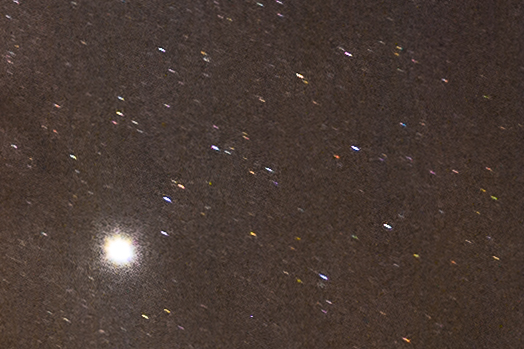
The 500 rule and NPF rule can guide you to the shutter speeds that give you this result, but they may still recommend something that’s a bit off from optimal. So, no matter which rule you use, I recommend zooming in on your Milky Way photos when you’re in the field and making sure that they look something like the image above.
I personally use 20 seconds by default with my 14mm lens, and sometimes up to 25 seconds. With my 20mm lens, that’s 15 and 20 seconds instead. I typically don’t change this shutter speed based on my camera or aperture, but I do try to figure out which direction I’m facing relative to the celestial equator to help make my decision. However, I’m also a bit more aggressive in general about using longer shutter speeds than some astrophotographers are, so I encourage you to test it yourself before using these exact values.
Eliminating Star Trails Completely
There are two ways to get zero star trailing whatsoever in your photos, without an extreme amount of noise: star trackers and image stacking.
The first method requires you to get a specialized tracking head that follows the movement of the stars. These allow you to use arbitrarily long shutter speeds without blurring the stars. For instance, I took the photo below at more than 14 minutes of exposure on a tracking head, and the stars are perfect pinpoints because the tracker followed them so well:
Of course, the ground is blurry now, so I took a separate image and blended them together:
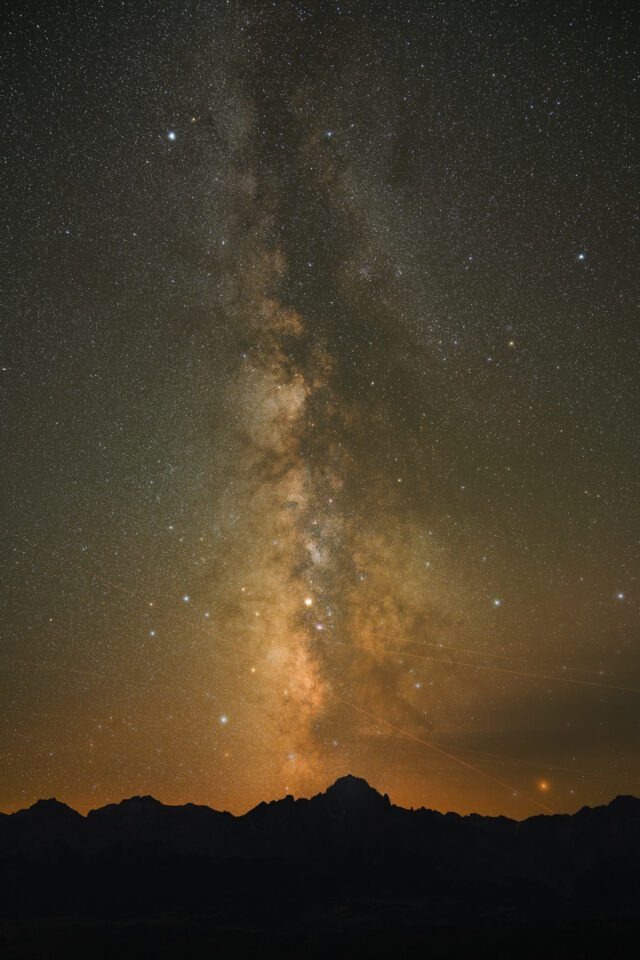
That method works well when your foreground has a sharp edge, like a mountain, but runs into issues for complex foregrounds like trees. At that point, the better option is to do “image averaging” instead. Essentially, you take a series of photos at a relatively short shutter speed like 5 or 10 seconds, combined with a high ISO. With specialized astrophotography software (Starry Landscape Stacker for Mac and Sequator for Windows), you can rotate and align the stars in the image without rotating the foreground, then average together your images to reduce noise.
I’ve written a full article about the technique here if you want more info. But the result is that you can get pinpoint stars with image quality equivalent to using a multi-minute exposure. That’s what I did here with 14 images, each taken at 10 seconds of exposure:
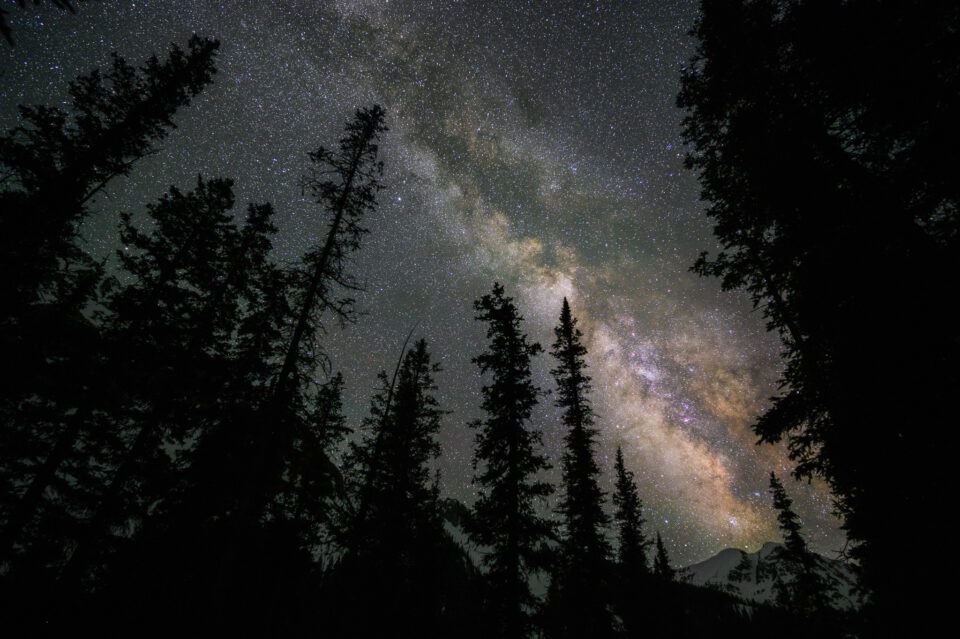
And you can see the level of detail (and lack of star trailing) in the crop:

For this method, it helps to use a shutter speed no longer than the strictest version of the NPF rule. Even in the over-the-top example I gave earlier of the Sony A7r IV with an f/1.4 lens, it’s better safe than sorry; if the NPF rule suggests no more than 4 seconds of exposure, that’s what you should use. (If you don’t have an NPF calculator handy, just use a shutter speed that feels excessively short, like 5-8 seconds.) Then, compensate for the individually short exposures by taking 30 or 40 images to get an equivalent exposure of several minutes long. Blend in your stacking software for great results.
Just like the others, though, this not always a perfect method. It isn’t fun to take dozens of photos to merge in a potentially time-consuming process later. But for photographers who see the “blur versus noise” dilemma and proudly yell “Neither!” – image averaging or a tracking head are your options.
Conclusion
It’s amazing how a simple topic like choosing your shutter speed for Milky Way photography can lead down all these rabbit holes. At the end of the day (literally), your decision may boil down to a simple choice between 15 seconds, 25 seconds, or somewhere in between – and you could even capture a variation of each, in less time than it takes to read this article!
But I do think it’s important to understand these fundamentals, including the simplifications that both the 500 rule and NPF rule make. You may get good photos most of the time just by choosing a formula’s recommendation, but in tricky situations, it’s critical to have more background knowledge. Even for standard astrophotography, wouldn’t you rather understand what’s going on below the surface, so you can feel more confident about your settings? I know I would.
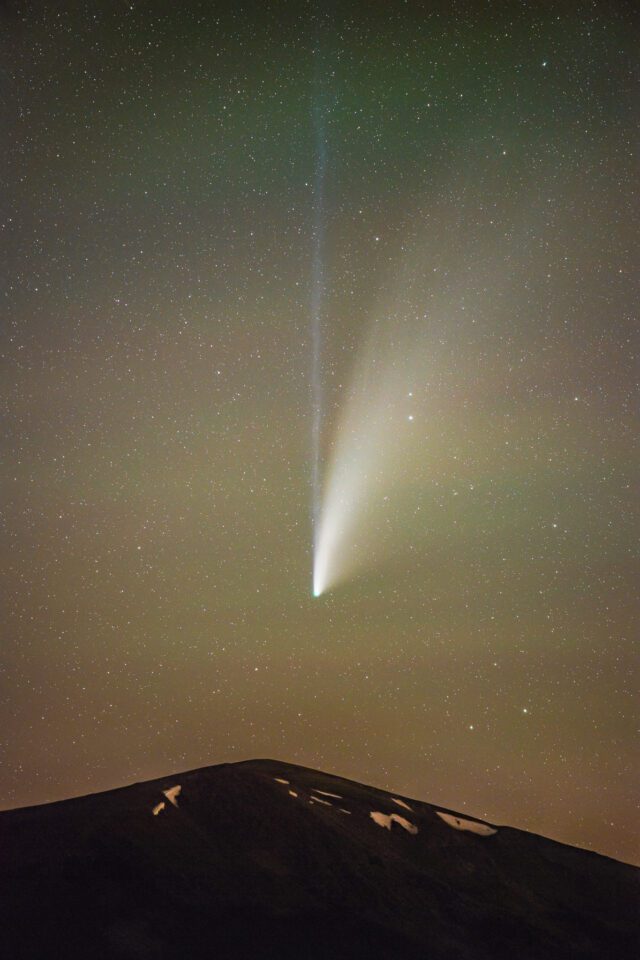
Hopefully this article clarified everything you were wondering about. If you have any questions about the 500 rule, NPF rule, or just astrophotography in general, let me know in the comments below!


